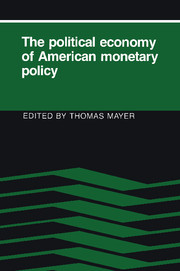Book contents
- Frontmatter
- Contents
- Preface
- List of contributors
- 1 Introduction
- 2 Studying the Fed: toward a broader public-choice perspective
- 3 The Federal Reserve reaction function: a specification search
- 4 Corporate profitability as a determinant of restrictive monetary policy: estimates for the postwar United States
- 5 Federal Reserve behavior since 1980: a financial-market perspective
- 6 The Federal Reserve and its institutional environment: a review
- 7 The political economy of monetary policy
- 8 Political monetary cycles
- 9 Congress and the Fed: why the dog does not bark in the night
- 10 The Federal Reserve as a political power
- 11 Monetary policy and political economy: the Federal Reserve and the Bank of Japan
- 12 A positive analysis of the policy-making process at the Federal Reserve
- 13 A theory of FOMC dissent voting with evidence from the time series
- 14 Explaining FOMC members' votes
- 15 Fed behavior and X-efficiency theory: toward a general framework
- 16 Minimizing regret: cognitive dissonance as an explanation of FOMC behavior
- 17 The discount window
- 18 Leaning against the wind: the behavior of the money stock in recession and recovery, 1953–8
- 19 Bureaucratic self-interest as an obstacle to monetary reform
- Index
17 - The discount window
Published online by Cambridge University Press: 06 July 2010
- Frontmatter
- Contents
- Preface
- List of contributors
- 1 Introduction
- 2 Studying the Fed: toward a broader public-choice perspective
- 3 The Federal Reserve reaction function: a specification search
- 4 Corporate profitability as a determinant of restrictive monetary policy: estimates for the postwar United States
- 5 Federal Reserve behavior since 1980: a financial-market perspective
- 6 The Federal Reserve and its institutional environment: a review
- 7 The political economy of monetary policy
- 8 Political monetary cycles
- 9 Congress and the Fed: why the dog does not bark in the night
- 10 The Federal Reserve as a political power
- 11 Monetary policy and political economy: the Federal Reserve and the Bank of Japan
- 12 A positive analysis of the policy-making process at the Federal Reserve
- 13 A theory of FOMC dissent voting with evidence from the time series
- 14 Explaining FOMC members' votes
- 15 Fed behavior and X-efficiency theory: toward a general framework
- 16 Minimizing regret: cognitive dissonance as an explanation of FOMC behavior
- 17 The discount window
- 18 Leaning against the wind: the behavior of the money stock in recession and recovery, 1953–8
- 19 Bureaucratic self-interest as an obstacle to monetary reform
- Index
Summary
Any Federal reserve bank may make advances for periods not exceeding 15 days to its member banks on their promissory notes secured by the deposit or pledge of bonds, notes, certificates of indebtedness, or Treasury bills of the United States … at rates to be established by such Federal reserve banks, such rates to be subject to the review and determination of the Board of Governors of the Federal Reserve System. Federal Reserve Act, Sec. 13(8)
As a student, I did not know where the term “discount window” came from. Why not “discount facility”? When I joined the staff of the Federal Reserve Bank of Boston in 1973, the mystery was solved. The bank was still housed in its old building, which had a grand banking lobby. And in the lobby was a teller's window with the word “Discount” above. It used to be that bankers would bring their collateral to the window and arrange their loans. The Boston Fed's new building does not have a teller's discount window, but the facility survives.
President Wilson signed the Federal Reserve Act into law on December 23, 1913, “to provide for the establishment of Federal reserve banks, to furnish an elastic currency, to afford means of rediscounting commercial paper, to establish a more effective supervision of banking in the United States, and for other purposes” (preamble, Federal Reserve Act). In 1913 the discount rate was the principal policy instrument, and the gold standard was taken for granted. Open-market operations had been invented, but not yet discovered.
- Type
- Chapter
- Information
- The Political Economy of American Monetary Policy , pp. 253 - 266Publisher: Cambridge University PressPrint publication year: 1990

